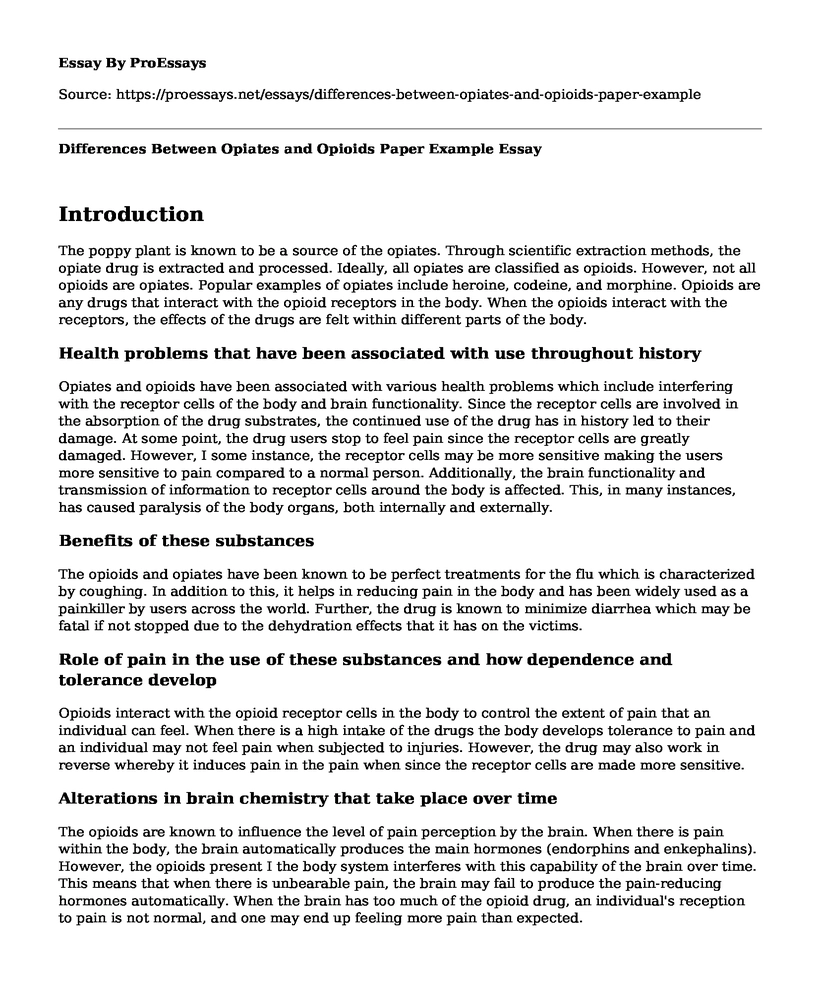Introduction
The poppy plant is known to be a source of the opiates. Through scientific extraction methods, the opiate drug is extracted and processed. Ideally, all opiates are classified as opioids. However, not all opioids are opiates. Popular examples of opiates include heroine, codeine, and morphine. Opioids are any drugs that interact with the opioid receptors in the body. When the opioids interact with the receptors, the effects of the drugs are felt within different parts of the body.
Health problems that have been associated with use throughout history
Opiates and opioids have been associated with various health problems which include interfering with the receptor cells of the body and brain functionality. Since the receptor cells are involved in the absorption of the drug substrates, the continued use of the drug has in history led to their damage. At some point, the drug users stop to feel pain since the receptor cells are greatly damaged. However, I some instance, the receptor cells may be more sensitive making the users more sensitive to pain compared to a normal person. Additionally, the brain functionality and transmission of information to receptor cells around the body is affected. This, in many instances, has caused paralysis of the body organs, both internally and externally.
Benefits of these substances
The opioids and opiates have been known to be perfect treatments for the flu which is characterized by coughing. In addition to this, it helps in reducing pain in the body and has been widely used as a painkiller by users across the world. Further, the drug is known to minimize diarrhea which may be fatal if not stopped due to the dehydration effects that it has on the victims.
Role of pain in the use of these substances and how dependence and tolerance develop
Opioids interact with the opioid receptor cells in the body to control the extent of pain that an individual can feel. When there is a high intake of the drugs the body develops tolerance to pain and an individual may not feel pain when subjected to injuries. However, the drug may also work in reverse whereby it induces pain in the pain when since the receptor cells are made more sensitive.
Alterations in brain chemistry that take place over time
The opioids are known to influence the level of pain perception by the brain. When there is pain within the body, the brain automatically produces the main hormones (endorphins and enkephalins). However, the opioids present I the body system interferes with this capability of the brain over time. This means that when there is unbearable pain, the brain may fail to produce the pain-reducing hormones automatically. When the brain has too much of the opioid drug, an individual's reception to pain is not normal, and one may end up feeling more pain than expected.
Sedative-Hypnotics
Purposes of prescribing medications
The drugs are mostly used by the idle and upper classes in the American society. They are used in the treatment of symptoms of anxiety and panic disorders. Serious problems related to anxiety can be solved by taking prescribed benzodiazepines. Also, it is used to reduce anxiety in surgical patients within medical facilities. Sleeping disorders, spasms, and seizures are treated using the sedatives and hypnotics. Acute alcohol withdrawal symptoms can also be treated using the benzodiazepines which are popular sedative-hypnotics.
Possible negative effects over long-term use
Long-term continued use of the sedative-hypnotics may lead to memory impairments. According to research, most users cannot retain long-term memories. They only have the capability of remembering things that happened in the short term. Their rains retention capabilities are interfered with. Additionally, with the continued use, the liver cells become damaged, and the users have a reduced tolerance to the drugs. Compared to the younger and newer users of the drugs, the older users are unable to process the drugs in their body due to the destroyed liver cells.
How they work in the body and brainWhen the drugs are ingested into the body, they are absorbed into the bloodstream where they are transported to different parts of the body. According to medical information, the liver plays the primary role of breaking down the drugs to substrates that are easily absorbed into the bloodstream. This then makes it easy to be transported to different parts of the body in the dissolved form. While in the brain, the drugs are absorbed with the help of the receptor cells. Continued use of the drugs without prescription may result in the damage of the receptor cells in eth long run. Some of the brain parts are damaged which thus affects the long-term memories of users in the long run.
Most common types of sedative-hypnotics that people use today:
- Barbiturates
- Meprobamate
- Glutethimide
- Pregabalin
- Ramelteon
- Zaleplon
Cite this page
Differences Between Opiates and Opioids Paper Example. (2022, Aug 23). Retrieved from https://proessays.net/essays/differences-between-opiates-and-opioids-paper-example
If you are the original author of this essay and no longer wish to have it published on the ProEssays website, please click below to request its removal:
- Case Study Example: A Social Work Student's Interview With the Client
- Pharmaceutical, Work Health and Safety Legislation
- Essay Sample on Public Health Policy Interventions: Advantages & Disadvantages
- Article Analysis Essay on Wastewater Reuse for Irrigation: Nutrient Recovery & Waste Disposal
- Essay on Community-Based Nursing: A Catalyst for Quality Care and Improved Outcomes
- Essay on Americans with Disabilities Act: Restricting Prejudice & Improving Accessibility
- Precision Medicine: Principles, Challenges, and Impact on Cancer Treatment - Free Paper







